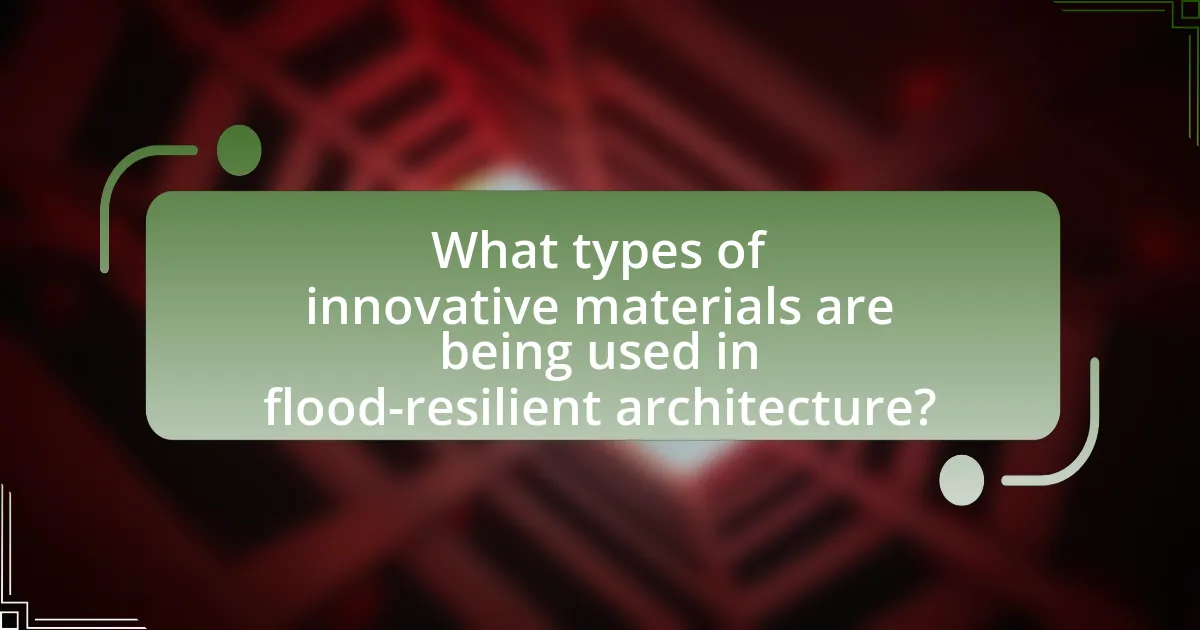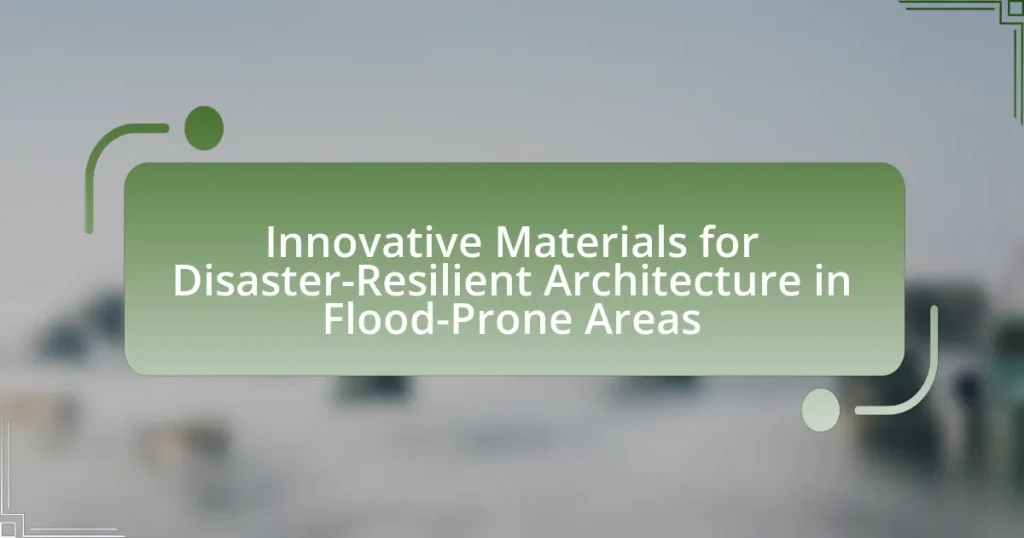The article focuses on innovative materials for disaster-resilient architecture specifically designed for flood-prone areas. It highlights various materials such as permeable concrete, modular floating structures, and bio-based options like bamboo and recycled plastics, which enhance structural integrity and reduce vulnerability to flooding. The discussion includes the properties that make these materials suitable for such environments, their economic benefits, and the challenges architects face in integrating them into building practices. Additionally, it addresses the environmental impacts of these materials and outlines best practices for ensuring compliance with safety standards and effective maintenance.

What are Innovative Materials for Disaster-Resilient Architecture in Flood-Prone Areas?
Innovative materials for disaster-resilient architecture in flood-prone areas include permeable concrete, which allows water to pass through and reduces runoff, and modular floating structures that can rise with floodwaters. Additionally, bio-based materials like bamboo and recycled plastics offer sustainable options that are lightweight and resistant to water damage. Research indicates that using these materials can significantly enhance the resilience of buildings against flooding, as demonstrated in case studies where permeable surfaces reduced flooding impacts by up to 30%.
How do these materials contribute to disaster resilience?
Innovative materials contribute to disaster resilience by enhancing structural integrity and reducing vulnerability to flooding. These materials, such as water-resistant composites and flexible building elements, can withstand extreme weather conditions and minimize damage during disasters. For instance, research indicates that using flood-resistant materials can reduce repair costs by up to 50% after a flood event, demonstrating their effectiveness in maintaining building functionality and safety. Additionally, materials designed for rapid drying and mold resistance further support recovery efforts, ensuring that structures remain habitable and safe post-disaster.
What specific properties make these materials suitable for flood-prone areas?
Materials suitable for flood-prone areas possess specific properties such as water resistance, durability, and lightweight characteristics. Water-resistant materials, like treated wood and certain composites, prevent water absorption, reducing structural damage during floods. Durability ensures that materials can withstand harsh conditions and repeated exposure to moisture, which is critical for maintaining integrity over time. Lightweight materials facilitate easier transportation and installation, allowing for rapid deployment in emergency situations. These properties collectively enhance the resilience of structures in flood-prone regions, ensuring safety and longevity.
How do innovative materials enhance structural integrity during floods?
Innovative materials enhance structural integrity during floods by providing superior resistance to water damage and structural failure. For instance, materials such as fiber-reinforced polymers and hydrophobic concrete are designed to repel water and resist corrosion, which significantly reduces the risk of structural degradation. Research indicates that structures utilizing these materials can maintain their load-bearing capacity even when submerged, as demonstrated in studies conducted by the National Institute of Standards and Technology, which found that hydrophobic treatments can increase the lifespan of concrete structures in flood-prone areas by up to 50%. Additionally, the use of lightweight, high-strength materials allows for more flexible designs that can better withstand the forces exerted by floodwaters, further enhancing overall structural resilience.
Why is disaster-resilient architecture important in flood-prone areas?
Disaster-resilient architecture is crucial in flood-prone areas because it minimizes damage and enhances safety during flooding events. This type of architecture employs design strategies and materials that can withstand water exposure, reducing the risk of structural failure and protecting inhabitants. For instance, elevated structures and water-resistant materials can prevent floodwaters from compromising the integrity of buildings. According to the National Institute of Building Sciences, implementing resilient design can save communities up to $4 for every $1 invested in disaster mitigation. This demonstrates that disaster-resilient architecture not only safeguards lives but also proves economically beneficial by reducing recovery costs after flooding incidents.
What are the risks associated with traditional building materials in floods?
Traditional building materials, such as wood, brick, and concrete, face significant risks during floods, primarily due to their susceptibility to water damage. Wood can rot and become structurally compromised when exposed to prolonged moisture, leading to potential collapse. Brick and concrete, while more durable, can suffer from erosion and cracking when subjected to floodwaters, which may weaken their integrity over time. Additionally, traditional materials often lack waterproofing properties, allowing water to penetrate and cause damage to the interior structures. Historical data indicates that buildings constructed with these materials in flood-prone areas frequently incur higher repair costs and longer recovery times compared to those built with modern, water-resistant alternatives.
How can innovative materials mitigate these risks?
Innovative materials can mitigate risks in flood-prone areas by enhancing structural resilience and reducing water damage. For instance, materials such as hydrophobic coatings and flood-resistant composites can repel water, preventing infiltration and damage to building components. Research indicates that using advanced polymers and engineered wood can improve durability and resistance to moisture, thereby extending the lifespan of structures in flood-prone regions. Additionally, the integration of smart materials that respond to environmental changes can provide real-time monitoring and adaptive responses, further safeguarding buildings against flood risks.

What types of innovative materials are being used in flood-resilient architecture?
Innovative materials used in flood-resilient architecture include permeable concrete, which allows water to pass through and reduces runoff, and modular floating structures that adapt to rising water levels. Additionally, bio-based materials like hempcrete and bamboo are utilized for their sustainability and resilience properties. Research indicates that these materials not only enhance structural integrity but also promote environmental sustainability, making them effective in mitigating flood risks.
What are the most common innovative materials currently in use?
The most common innovative materials currently in use for disaster-resilient architecture in flood-prone areas include engineered wood, fiber-reinforced polymers, and self-healing concrete. Engineered wood, such as cross-laminated timber, offers high strength-to-weight ratios and sustainability, making it suitable for resilient structures. Fiber-reinforced polymers provide corrosion resistance and lightweight properties, enhancing durability in harsh environments. Self-healing concrete incorporates bacteria that precipitate calcium carbonate to fill cracks, significantly extending the lifespan of structures exposed to water damage. These materials are increasingly adopted due to their performance characteristics and ability to withstand flooding conditions.
How do these materials compare to conventional materials?
Innovative materials for disaster-resilient architecture in flood-prone areas typically offer superior performance compared to conventional materials. These innovative materials, such as advanced composites and hydrophobic coatings, provide enhanced durability, water resistance, and structural integrity under extreme conditions. For instance, studies have shown that materials like fiber-reinforced polymers can withstand higher levels of moisture and stress than traditional concrete, reducing the risk of structural failure during floods. Additionally, the use of these materials can lead to lower maintenance costs and longer lifespans, as evidenced by research indicating that buildings constructed with innovative materials can last up to 50% longer than those built with conventional materials.
What are the environmental impacts of these innovative materials?
Innovative materials for disaster-resilient architecture in flood-prone areas can significantly reduce environmental impacts by minimizing resource consumption and enhancing sustainability. These materials often incorporate recycled content, which decreases the demand for virgin resources and reduces waste. For instance, the use of recycled plastics in construction can divert millions of tons of waste from landfills, while also lowering carbon emissions associated with material production. Additionally, many innovative materials are designed to be more energy-efficient, leading to lower greenhouse gas emissions during their lifecycle. Research indicates that using such materials can result in a 30% reduction in energy consumption compared to traditional building materials, thereby contributing to a smaller carbon footprint.
How are these materials sourced and manufactured?
Innovative materials for disaster-resilient architecture in flood-prone areas are sourced through sustainable practices and manufactured using advanced technologies. These materials often originate from recycled sources, such as reclaimed wood, recycled plastics, and industrial by-products, which reduces environmental impact. Manufacturing processes typically involve techniques like 3D printing and modular construction, allowing for efficient production and customization. For instance, the use of geopolymer concrete, which is made from industrial waste like fly ash, demonstrates a sustainable approach that not only minimizes waste but also enhances durability against flooding.
What sustainable practices are involved in the production of these materials?
Sustainable practices in the production of innovative materials for disaster-resilient architecture in flood-prone areas include the use of recycled materials, low-impact manufacturing processes, and renewable resources. For instance, utilizing recycled plastics and metals reduces waste and conserves natural resources, while low-energy production techniques minimize carbon emissions. Additionally, sourcing materials from renewable resources, such as bamboo or sustainably harvested wood, supports ecosystem health and reduces reliance on non-renewable materials. These practices not only enhance the sustainability of the materials but also contribute to the overall resilience of structures in flood-prone environments.
How does the sourcing of materials affect their performance in floods?
The sourcing of materials significantly affects their performance in floods by determining their durability, water resistance, and structural integrity. Materials sourced from local, sustainable suppliers often exhibit better adaptability to regional flood conditions, as they are selected based on local environmental factors. For instance, materials like bamboo and certain engineered woods, which are sourced sustainably, have shown enhanced resilience due to their natural properties and lower environmental impact. Research indicates that using locally sourced materials can reduce transportation emissions and costs, while also ensuring that the materials are better suited to withstand local flooding patterns, as evidenced by studies on flood-resistant building practices in regions like Bangladesh.

What are the challenges and limitations of using innovative materials in flood-prone architecture?
The challenges and limitations of using innovative materials in flood-prone architecture include high costs, regulatory hurdles, and performance uncertainties. High costs can deter widespread adoption, as many innovative materials require significant investment in research and development, as well as specialized manufacturing processes. Regulatory hurdles arise from building codes and standards that may not yet accommodate new materials, leading to delays in approval and implementation. Performance uncertainties stem from the lack of long-term data on how these materials withstand extreme flooding conditions, which can create risks for safety and durability. For instance, while some innovative materials may offer enhanced water resistance, their long-term effectiveness in real-world flood scenarios remains largely untested, raising concerns among architects and builders.
What are the cost implications of using these materials?
The cost implications of using innovative materials for disaster-resilient architecture in flood-prone areas can be significant, often leading to higher initial investment but potentially lower long-term expenses. For instance, materials such as advanced composites and flood-resistant concrete may have higher upfront costs compared to traditional building materials; however, their durability and resistance to water damage can reduce maintenance and repair costs over time. A study by the National Institute of Standards and Technology indicates that investing in resilient materials can lead to a 20-30% reduction in overall lifecycle costs due to decreased damage from flooding events. Thus, while the initial expenditure may be greater, the long-term financial benefits and risk mitigation justify the investment in these innovative materials.
How do initial costs compare to long-term benefits?
Initial costs for innovative materials in disaster-resilient architecture are often higher than traditional materials, but the long-term benefits significantly outweigh these initial expenses. For example, materials designed to withstand flooding can reduce repair and replacement costs over time, leading to savings that can exceed initial investments by up to 50% over a 20-year period. Additionally, these materials can enhance property value and reduce insurance premiums, further demonstrating their financial advantages in the long run. Studies indicate that buildings constructed with resilient materials experience fewer damages and lower maintenance costs, reinforcing the economic rationale for investing in such technologies despite higher upfront costs.
What funding options are available for implementing these materials?
Funding options for implementing innovative materials for disaster-resilient architecture in flood-prone areas include government grants, private sector investments, and international aid programs. Government grants, such as those from the Federal Emergency Management Agency (FEMA) in the United States, provide financial support specifically for projects aimed at enhancing resilience against flooding. Private sector investments can come from companies focused on sustainability and disaster recovery, which may offer funding or partnerships for innovative building materials. Additionally, international aid programs, such as those from the United Nations or World Bank, often allocate funds for infrastructure projects in vulnerable regions, promoting the use of advanced materials to mitigate disaster impacts. These funding sources are critical for advancing the implementation of effective architectural solutions in flood-prone areas.
What technical challenges do architects face when integrating these materials?
Architects face several technical challenges when integrating innovative materials for disaster-resilient architecture in flood-prone areas. One significant challenge is ensuring the materials’ durability and resistance to water damage, as flooding can compromise structural integrity. For instance, materials must be tested for their performance under prolonged exposure to moisture, which can lead to deterioration or failure. Additionally, architects must consider the compatibility of these materials with existing construction techniques and local building codes, which may not account for new innovations. This can complicate the design and approval process, as architects need to demonstrate that these materials meet safety and performance standards. Furthermore, the cost implications of sourcing and implementing these advanced materials can pose financial challenges, particularly in budget-constrained projects.
How can architects overcome these challenges?
Architects can overcome challenges in disaster-resilient architecture by utilizing innovative materials specifically designed for flood-prone areas. These materials, such as water-resistant composites and elevated building systems, enhance structural integrity and reduce damage during flooding events. For instance, the use of flood-resistant concrete can withstand prolonged exposure to water, while modular construction techniques allow for quicker assembly and adaptability to changing environmental conditions. Research indicates that buildings constructed with these materials can reduce repair costs by up to 50% after a flood, demonstrating their effectiveness in mitigating disaster impacts.
What role does technology play in the application of innovative materials?
Technology plays a crucial role in the application of innovative materials by enabling the development, testing, and implementation of advanced solutions tailored for disaster-resilient architecture. For instance, technologies such as computer-aided design (CAD) and simulation software allow architects and engineers to model the performance of new materials under various environmental conditions, ensuring they meet safety and durability standards. Additionally, advancements in material science, such as nanotechnology and smart materials, enhance the properties of construction materials, making them more resistant to flooding and other disasters. Research indicates that the integration of these technologies can significantly improve the resilience of structures, as seen in projects that utilize self-healing concrete and water-resistant coatings, which have been shown to reduce damage during flood events.
What best practices should be followed when using innovative materials for disaster-resilient architecture?
Best practices for using innovative materials in disaster-resilient architecture include selecting materials with high durability and resistance to environmental stressors, such as flooding and wind. For instance, using materials like fiber-reinforced polymers can enhance structural integrity and longevity. Additionally, integrating sustainable materials that are locally sourced reduces transportation emissions and supports the local economy. Employing modular construction techniques allows for quicker assembly and adaptability to changing conditions. Furthermore, conducting thorough risk assessments and simulations can inform material choices based on specific environmental threats. Research indicates that buildings designed with these practices can withstand extreme weather events more effectively, as evidenced by case studies in regions affected by hurricanes and floods.
How can architects ensure compliance with safety standards?
Architects can ensure compliance with safety standards by integrating building codes and regulations into their design processes. This involves staying updated on local, national, and international safety standards, such as the International Building Code (IBC) and the National Fire Protection Association (NFPA) guidelines. Additionally, architects should conduct thorough risk assessments to identify potential hazards specific to flood-prone areas, ensuring that materials and construction methods meet resilience criteria. For instance, using flood-resistant materials and designing for proper drainage can significantly enhance safety compliance. Regular collaboration with engineers and safety inspectors throughout the design and construction phases further reinforces adherence to safety standards.
What maintenance practices are recommended for structures built with these materials?
Regular inspections and timely repairs are essential maintenance practices for structures built with innovative materials in flood-prone areas. These practices ensure the integrity and longevity of the materials, which may include advanced composites, treated wood, or specialized concrete. For instance, inspecting for signs of water damage, corrosion, or structural fatigue allows for early intervention, preventing more extensive damage. Additionally, applying protective coatings can enhance the durability of materials against moisture and biological growth, which are common in flood-prone environments. Research indicates that proactive maintenance can extend the lifespan of such structures by up to 30%, emphasizing the importance of these practices in disaster-resilient architecture.




